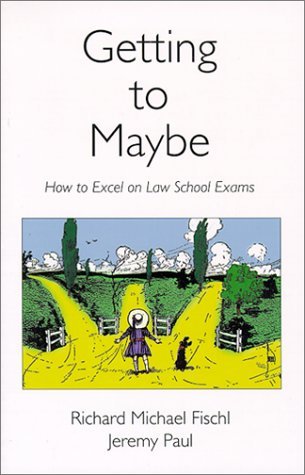Welcome to Study Aid Spotlight! This is a new, semi-regular series that will pop up at the Blackacre Times from time to time, especially as we near exam season. As the name suggests, each installment of Study Aid Spotlight will take an in-depth look at one particular study aid, discussing what it covers and why its useful. Go here if you want some study aid-related tips (alongside some choice iambs), or check out our Study Aid Finder for an easy entryway to the library’s collection. In this first installment of Study Aid Spotlight, Digital Services Librarian Gerard Fowke takes a closer look at Fischl & Paul’s classic Getting to Maybe: How to Excel on Law School Exams.
Here at the Blackacre Times, our ‘all-time’ most popular post is ’14 grad Hanish Patel’s convincing case for Glannon’s CivPro E&E as the ‘all-time’ #1 study aid. And it’s easy to see why the CivPro E&E might warrant such effusive praise: Professor Glannon’s masterful hypos force students to think critically about these storied doctrines, and his witty presentation makes this rather dry material quite memorable.
But I’m here to tell you that Richard Michael Fischl & Jeremy Paul’s Getting to Maybe 1 gives Glannon a run for its money.
Why? Well, it’s right there in the subtitle. ‘Law Schools Exams’ can seem awfully important, and G2M is all about ‘How to Excel ’ on these challenging and mysterious assessments. And unlike Glannon, which will only help in CivPro, G2M’s focus on exam-related skills will help you in all of your classes. Every. Single. One.

Notably, this helpfulness even encompasses those classes without a traditional law school exam. That’s because this study aid’s exam-oriented focus is really just the tip of the iceberg. Although its strategies will undoubtedly prove helpful when untangling an end-of-semester issue-spotter, that’s only because everything about law school revolves around G2M’s true topic: legal analysis.
For example, take Chapter 6, titled “Forks in the Facts.” Here, Fischl & Paul start by telling us they plan to look at a “variety of ways in which laws are structured by category” and explain the challenges of categorizing “a particular set of facts.” Then they proceed to do just that, with subchapters on oft-seen iterations of this analytical concept, such as “Rule vs. Exception,” “Categories as Elements of Legal Rules,” and “Facts on Both Sides.” For each, the authors illustrate their ideas with clear examples drawn from the casebook canon (some even involving everyone’s favorite fictional estate).

But this “categorical” habit of thought will only help you succeed on an exam because it’s an important aspect of legal analysis. And it has rarely (if ever) been given this straightforward of a treatment: the authors have cleared away the jurisprudential rabbit-holes and distilled the essence of “categorical reasoning about the law” into fewer than 20 pages.
In Maybe‘s remainder, they work similar wonders with kindred concepts like “Forks in the Law” and “Patterns of Ambiguity.” Students will walk away wishing they could stop thinking like a lawyer.
Of course, this approach means that Getting to Maybe is less of a reference work than something like the Glannon E&E. It’s not the study aid you’ll grab from the nightstand for that day-before-the-exam Erie refresher. Instead, most students will want to read G2M once or twice (preferably before the exam ‘crunch’ begins), absorb its analytical framework, and move on. This quality alone probably makes it a perpetual underdog in the study aid “World Series.” Still, few books so effectively capture the essence of what law school seeks to impart and assess. The E&Es and Nutshells of the world would do well to watch out for the weird, scrappy study aid known as Getting to Maybe.
1 I couldn’t help but to completely and utterly geek out when I noticed that Professor Paul’s faculty profile mentions that a new edition of Getting to Maybe is expected for 2021. The first (and only) edition has been out for 22 years. UPDATE: According to Carolina Academic Press (by the way of the Jones School of Law Library’s Gigi Panagotacos) the new edition won’t be out until Fall 2022. Can I even wait that long?